Abstract
This study was based on an initial observation that, although culture of T cells from Salmonella-infected mice with concanavalin A induced both L3T4+ T cells and Lyt-2+ T cells to proliferate, there was a relative increase in the responsiveness of the Lyt-2+ T cells in suspensions harvested from mice with secondary infection. Accordingly, primed T cells, obtained from the peritoneal cavities and spleens of mice that had received one or two intraperitoneal doses of Salmonella were examined for the presence of antigen-specific, class I major histocompatibility complex (MHC)-restricted Lyt-2+ T cells. After primary infection with avirulent Salmonella enteritidis 11RX (11RX) only L3T4+ T cells could be induced to proliferate in response to formalin-killed 11RX organisms, and a second dose of live 11RX did not change the phenotype of the responding T-cell population. In contrast, secondary challenge with S. typhimurium C5 (C5) generated cell populations where both L3T4+ and Lyt-2+ T cells proliferated when cultured with formalin-killed 11RX. Transfer of delayed-type hypersensitivity (DTH) using mixtures of primed T cells and either killed or live Salmonella organisms demonstrated that DTH was mediated by L3T4+ T cells, and secondary infection with either the 11RX or C5 strain did not change this result. However, antigen-specific Lyt-2+ T cells which mediated DTH reactivity were detected using a Salmonella-infected cell line which expressed MHC-coded class I but not class II products. These Lyt-2+ T cells were present in the spleen and peritoneal cavity after secondary infection and in the peritoneal cavity late after a primary infection with 11RX.
Full text
PDF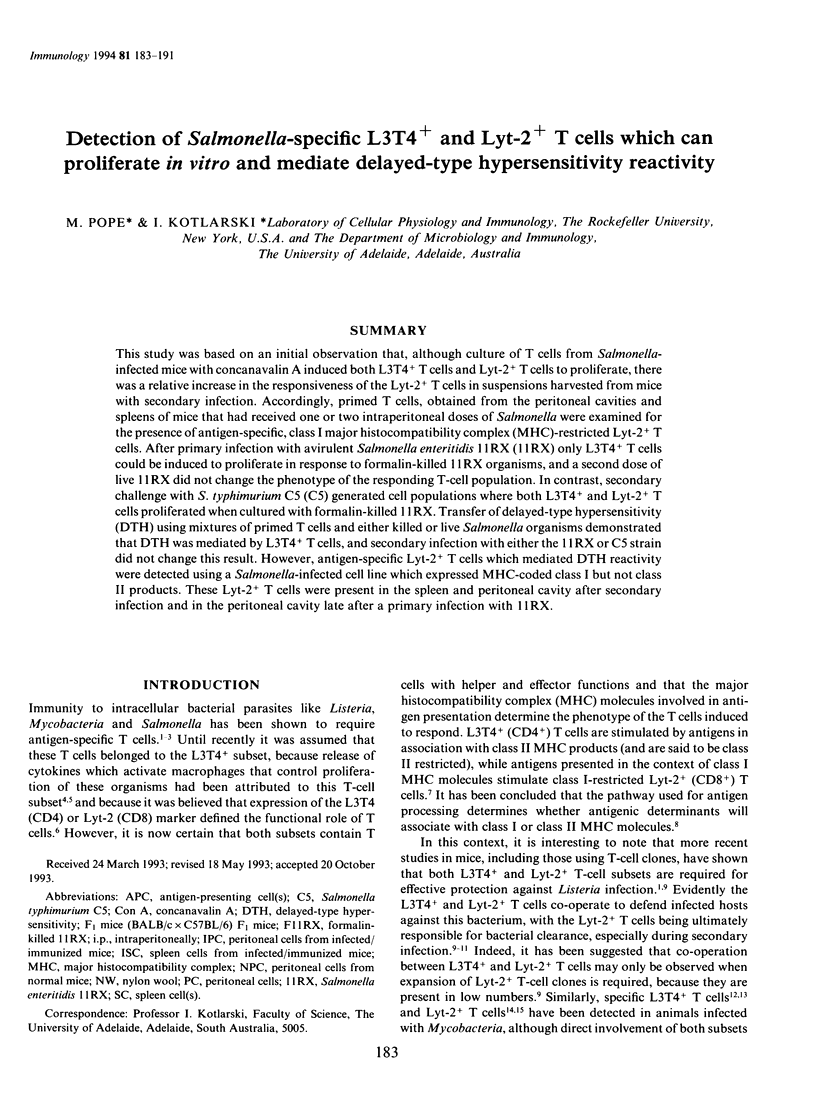
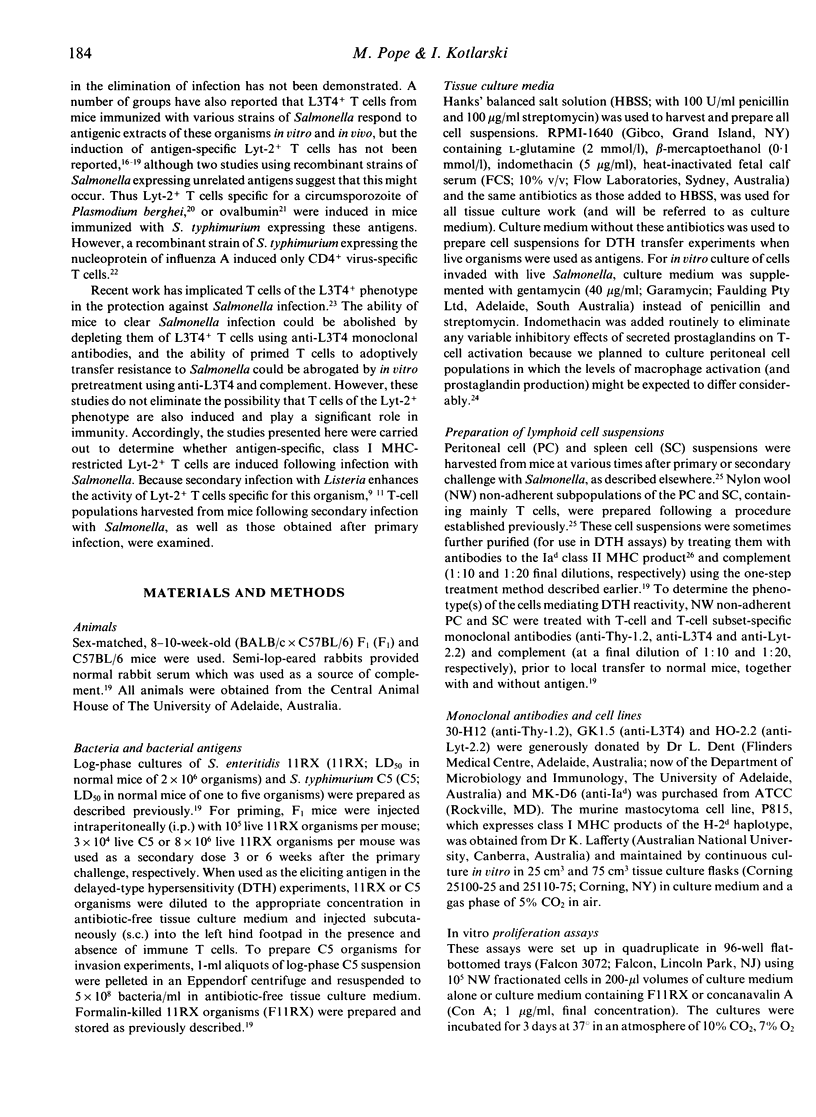
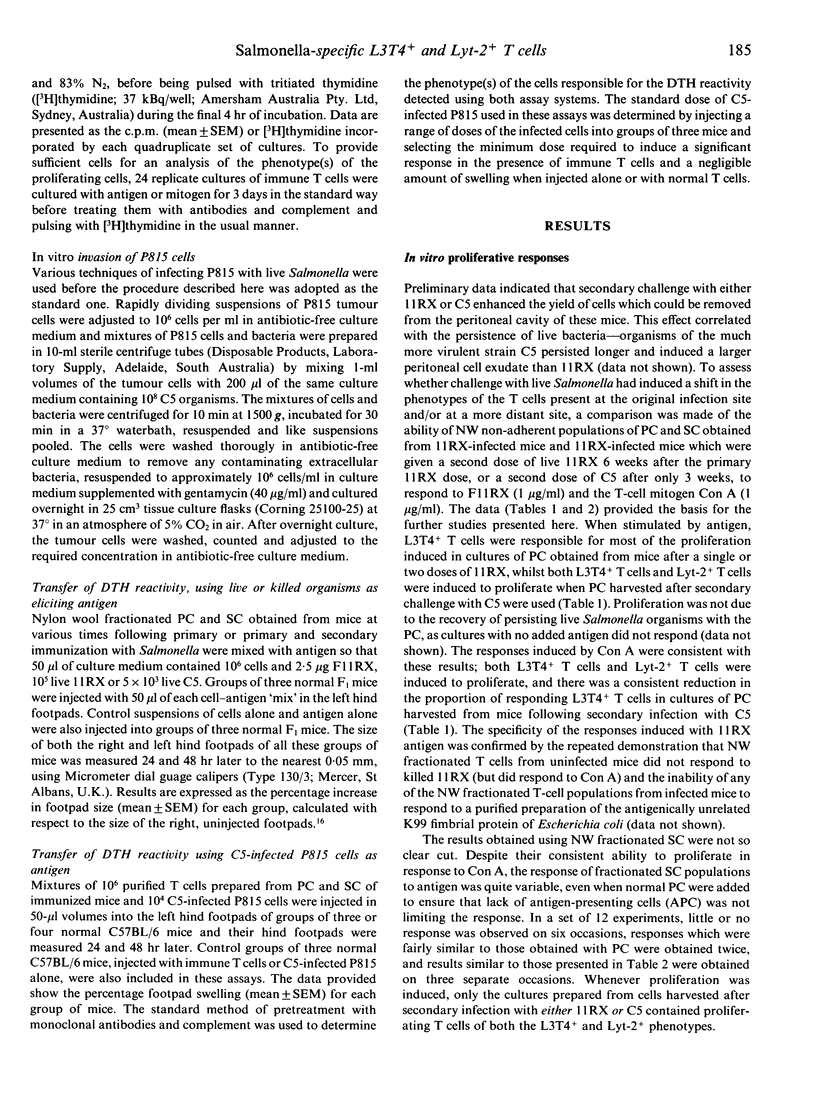
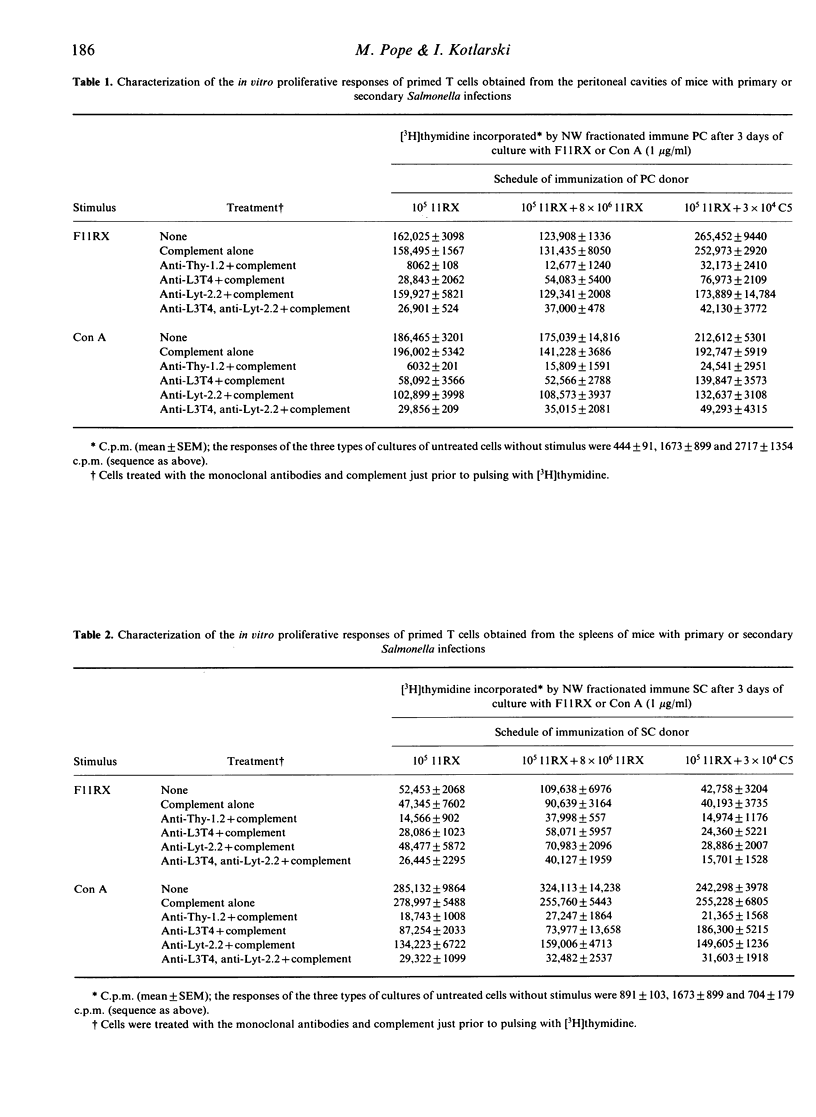
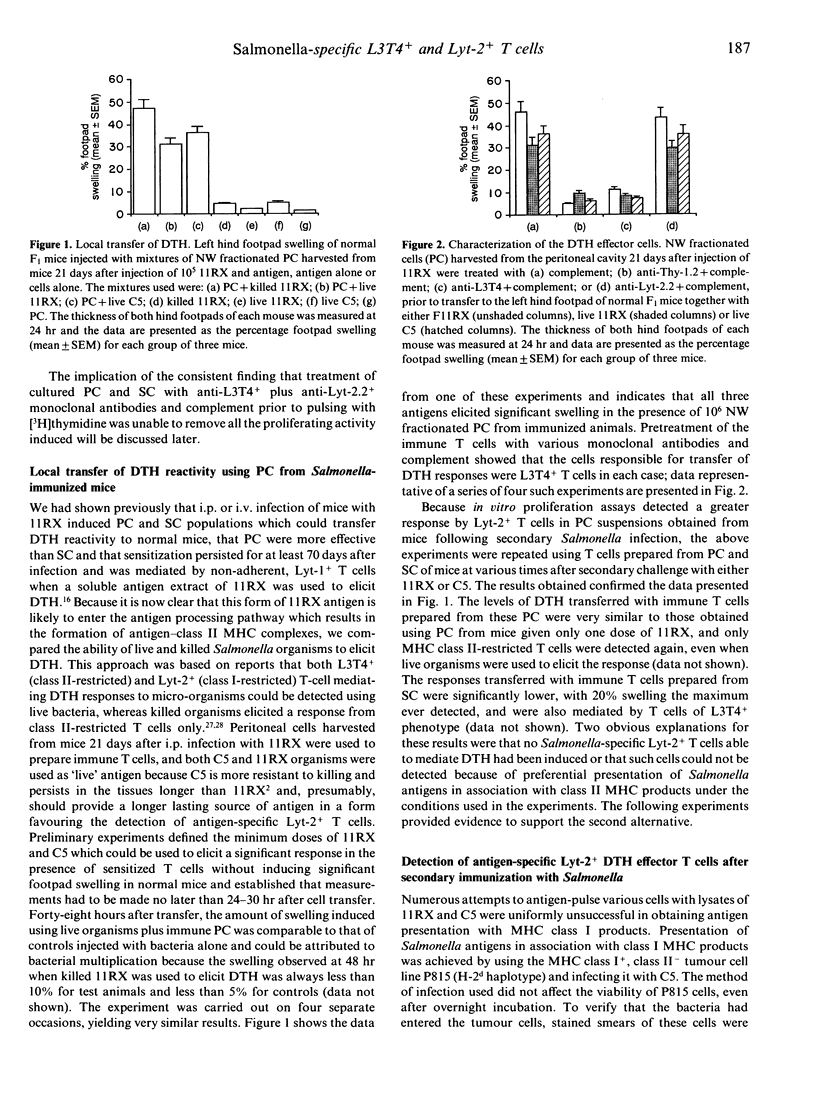
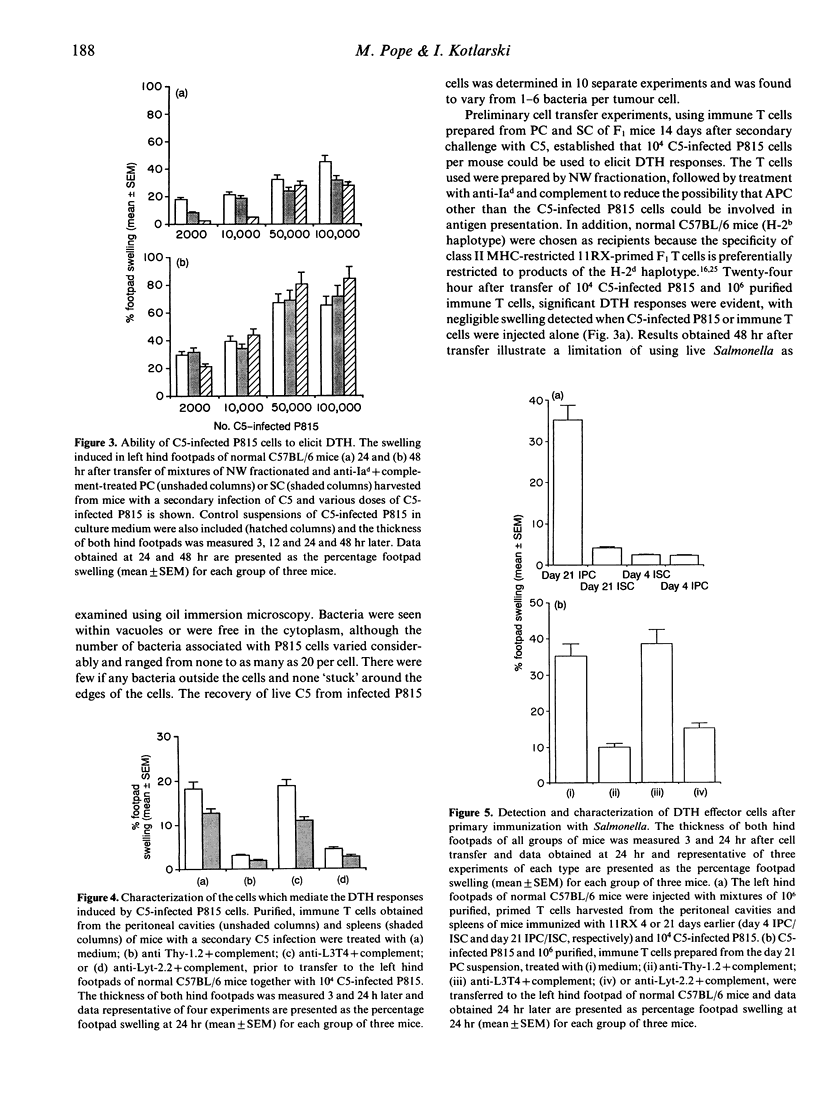

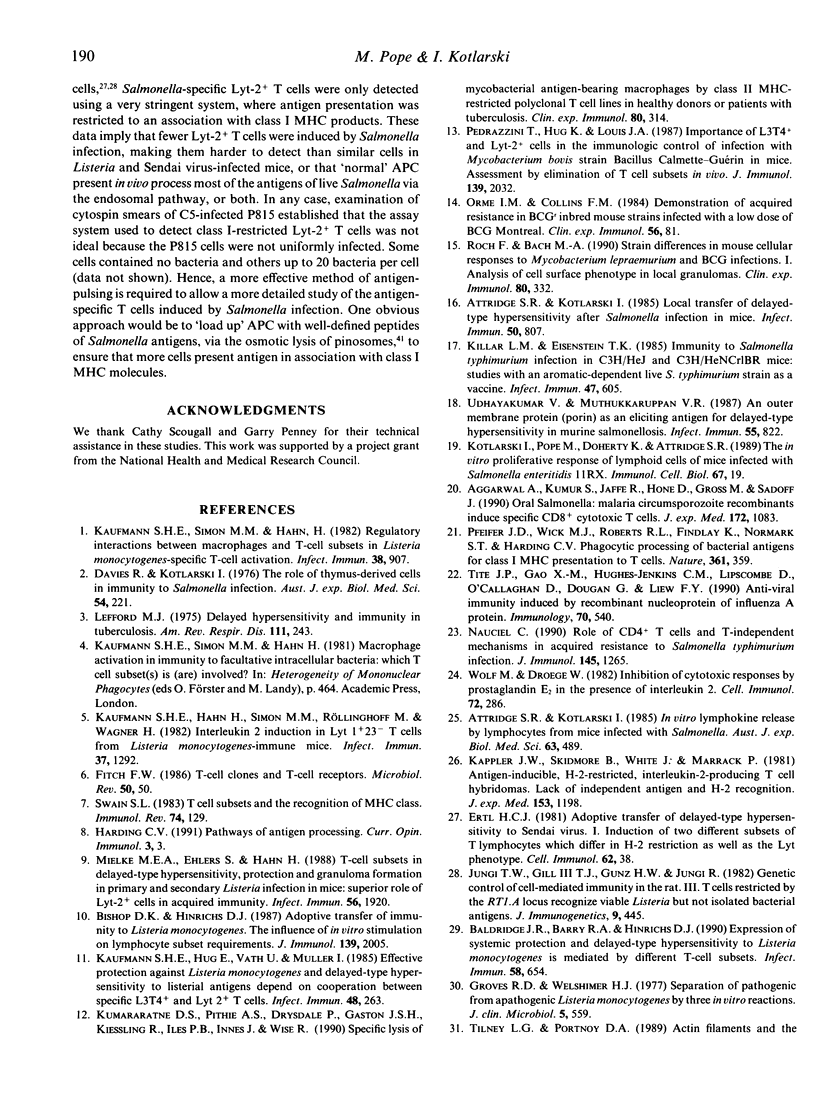
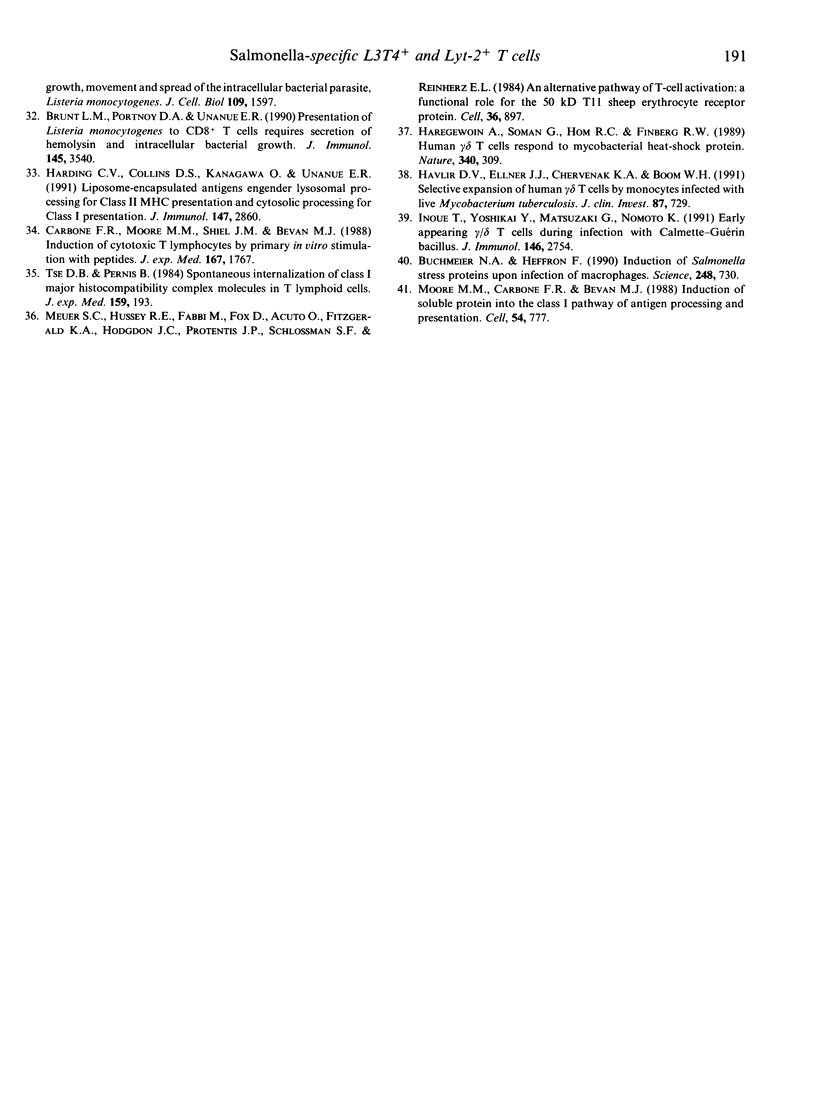
Selected References
These references are in PubMed. This may not be the complete list of references from this article.
- Aggarwal A., Kumar S., Jaffe R., Hone D., Gross M., Sadoff J. Oral Salmonella: malaria circumsporozoite recombinants induce specific CD8+ cytotoxic T cells. J Exp Med. 1990 Oct 1;172(4):1083–1090. doi: 10.1084/jem.172.4.1083. [DOI] [PMC free article] [PubMed] [Google Scholar]
- Attridge S. R., Kotlarski I. In vitro lymphokine release by lymphocytes from mice infected with Salmonella. Aust J Exp Biol Med Sci. 1985 Oct;63(Pt 5):489–502. doi: 10.1038/icb.1985.53. [DOI] [PubMed] [Google Scholar]
- Attridge S. R., Kotlarski I. Local transfer of delayed-type hypersensitivity after Salmonella infection in mice. Infect Immun. 1985 Dec;50(3):807–812. doi: 10.1128/iai.50.3.807-812.1985. [DOI] [PMC free article] [PubMed] [Google Scholar]
- Baldridge J. R., Barry R. A., Hinrichs D. J. Expression of systemic protection and delayed-type hypersensitivity to Listeria monocytogenes is mediated by different T-cell subsets. Infect Immun. 1990 Mar;58(3):654–658. doi: 10.1128/iai.58.3.654-658.1990. [DOI] [PMC free article] [PubMed] [Google Scholar]
- Bishop D. K., Hinrichs D. J. Adoptive transfer of immunity to Listeria monocytogenes. The influence of in vitro stimulation on lymphocyte subset requirements. J Immunol. 1987 Sep 15;139(6):2005–2009. [PubMed] [Google Scholar]
- Brunt L. M., Portnoy D. A., Unanue E. R. Presentation of Listeria monocytogenes to CD8+ T cells requires secretion of hemolysin and intracellular bacterial growth. J Immunol. 1990 Dec 1;145(11):3540–3546. [PubMed] [Google Scholar]
- Buchmeier N. A., Heffron F. Induction of Salmonella stress proteins upon infection of macrophages. Science. 1990 May 11;248(4956):730–732. doi: 10.1126/science.1970672. [DOI] [PubMed] [Google Scholar]
- Carbone F. R., Moore M. W., Sheil J. M., Bevan M. J. Induction of cytotoxic T lymphocytes by primary in vitro stimulation with peptides. J Exp Med. 1988 Jun 1;167(6):1767–1779. doi: 10.1084/jem.167.6.1767. [DOI] [PMC free article] [PubMed] [Google Scholar]
- Davies R., Kotlarski I. The role of thymus-derived cells in immunity to salmonella infection. Aust J Exp Biol Med Sci. 1976 Jun;54(3):221–236. doi: 10.1038/icb.1976.23. [DOI] [PubMed] [Google Scholar]
- Ertl H. C. Adoptive transfer of delayed-type hypersensitivity to Sendai virus. I. Induction of two different subsets of T lymphocytes which differ in H-2 restriction as well as in the Lyt phenotype. Cell Immunol. 1981 Jul 15;62(1):38–49. doi: 10.1016/0008-8749(81)90297-5. [DOI] [PubMed] [Google Scholar]
- Fitch F. W. T-cell clones and T-cell receptors. Microbiol Rev. 1986 Mar;50(1):50–69. doi: 10.1128/mr.50.1.50-69.1986. [DOI] [PMC free article] [PubMed] [Google Scholar]
- Groves R. D., Welshimer H. J. Separation of pathogenic from apathogenic Listeria monocytogenes by three in vitro reactions. J Clin Microbiol. 1977 Jun;5(6):559–563. doi: 10.1128/jcm.5.6.559-563.1977. [DOI] [PMC free article] [PubMed] [Google Scholar]
- Harding C. V., Collins D. S., Kanagawa O., Unanue E. R. Liposome-encapsulated antigens engender lysosomal processing for class II MHC presentation and cytosolic processing for class I presentation. J Immunol. 1991 Nov 1;147(9):2860–2863. [PubMed] [Google Scholar]
- Harding C. V. Pathways of antigen processing. Curr Opin Immunol. 1991 Feb;3(1):3–9. doi: 10.1016/0952-7915(91)90068-c. [DOI] [PubMed] [Google Scholar]
- Haregewoin A., Soman G., Hom R. C., Finberg R. W. Human gamma delta+ T cells respond to mycobacterial heat-shock protein. Nature. 1989 Jul 27;340(6231):309–312. doi: 10.1038/340309a0. [DOI] [PubMed] [Google Scholar]
- Havlir D. V., Ellner J. J., Chervenak K. A., Boom W. H. Selective expansion of human gamma delta T cells by monocytes infected with live Mycobacterium tuberculosis. J Clin Invest. 1991 Feb;87(2):729–733. doi: 10.1172/JCI115053. [DOI] [PMC free article] [PubMed] [Google Scholar]
- Inoue T., Yoshikai Y., Matsuzaki G., Nomoto K. Early appearing gamma/delta-bearing T cells during infection with Calmétte Guérin bacillus. J Immunol. 1991 Apr 15;146(8):2754–2762. [PubMed] [Google Scholar]
- Jungi T. W., Gill T. J., 3rd, Kunz H. W., Jungi R. Genetic control of cell-mediated immunity in the rat. III. T cells restricted by the RT1.A locus recognize viable Listeria but not isolated bacterial antigens. J Immunogenet. 1982 Dec;9(6):445–456. doi: 10.1111/j.1744-313x.1982.tb01006.x. [DOI] [PubMed] [Google Scholar]
- Kappler J. W., Skidmore B., White J., Marrack P. Antigen-inducible, H-2-restricted, interleukin-2-producing T cell hybridomas. Lack of independent antigen and H-2 recognition. J Exp Med. 1981 May 1;153(5):1198–1214. doi: 10.1084/jem.153.5.1198. [DOI] [PMC free article] [PubMed] [Google Scholar]
- Kaufmann S. H., Hahn H., Simon M. M., Röllinghoff M., Wagner H. Interleukin 2 induction in Lyt 1+ 23- T cells from Listeria monocytogenes-immune mice. Infect Immun. 1982 Sep;37(3):1292–1294. doi: 10.1128/iai.37.3.1292-1294.1982. [DOI] [PMC free article] [PubMed] [Google Scholar]
- Kaufmann S. H., Hug E., Väth U., Müller I. Effective protection against Listeria monocytogenes and delayed-type hypersensitivity to listerial antigens depend on cooperation between specific L3T4+ and Lyt 2+ T cells. Infect Immun. 1985 Apr;48(1):263–266. doi: 10.1128/iai.48.1.263-266.1985. [DOI] [PMC free article] [PubMed] [Google Scholar]
- Kaufmann S. H., Simon M. M., Hahn H. Regulatory interactions between macrophages and T-cell subsets in Listeria monocytogenes-specific T-cell activation. Infect Immun. 1982 Dec;38(3):907–913. doi: 10.1128/iai.38.3.907-913.1982. [DOI] [PMC free article] [PubMed] [Google Scholar]
- Killar L. M., Eisenstein T. K. Immunity to Salmonella typhimurium infection in C3H/HeJ and C3H/HeNCrlBR mice: studies with an aromatic-dependent live S. typhimurium strain as a vaccine. Infect Immun. 1985 Mar;47(3):605–612. doi: 10.1128/iai.47.3.605-612.1985. [DOI] [PMC free article] [PubMed] [Google Scholar]
- Kotlarski I., Pope M., Doherty K., Attridge S. R. The in vitro proliferative response of lymphoid cells of mice infected with Salmonella enteritidis 11RX. Immunol Cell Biol. 1989 Feb;67(Pt 1):19–29. doi: 10.1038/icb.1989.3. [DOI] [PubMed] [Google Scholar]
- Kumararatne D. S., Pithie A. S., Drysdale P., Gaston J. S., Kiessling R., Iles P. B., Ellis C. J., Innes J., Wise R. Specific lysis of mycobacterial antigen-bearing macrophages by class II MHC-restricted polyclonal T cell lines in healthy donors or patients with tuberculosis. Clin Exp Immunol. 1990 Jun;80(3):314–323. doi: 10.1111/j.1365-2249.1990.tb03287.x. [DOI] [PMC free article] [PubMed] [Google Scholar]
- Lefford M. J. Editorial: Delayed hypersensitivity and immunity in tuberculosis. Am Rev Respir Dis. 1975 Mar;111(3):243–246. doi: 10.1164/arrd.1975.111.3.243. [DOI] [PubMed] [Google Scholar]
- Meuer S. C., Hussey R. E., Fabbi M., Fox D., Acuto O., Fitzgerald K. A., Hodgdon J. C., Protentis J. P., Schlossman S. F., Reinherz E. L. An alternative pathway of T-cell activation: a functional role for the 50 kd T11 sheep erythrocyte receptor protein. Cell. 1984 Apr;36(4):897–906. doi: 10.1016/0092-8674(84)90039-4. [DOI] [PubMed] [Google Scholar]
- Mielke M. E., Ehlers S., Hahn H. T-cell subsets in delayed-type hypersensitivity, protection, and granuloma formation in primary and secondary Listeria infection in mice: superior role of Lyt-2+ cells in acquired immunity. Infect Immun. 1988 Aug;56(8):1920–1925. doi: 10.1128/iai.56.8.1920-1925.1988. [DOI] [PMC free article] [PubMed] [Google Scholar]
- Moore M. W., Carbone F. R., Bevan M. J. Introduction of soluble protein into the class I pathway of antigen processing and presentation. Cell. 1988 Sep 9;54(6):777–785. doi: 10.1016/s0092-8674(88)91043-4. [DOI] [PubMed] [Google Scholar]
- Nauciel C. Role of CD4+ T cells and T-independent mechanisms in acquired resistance to Salmonella typhimurium infection. J Immunol. 1990 Aug 15;145(4):1265–1269. [PubMed] [Google Scholar]
- Orme I. M., Collins F. M. Demonstration of acquired resistance in Bcgr inbred mouse strains infected with a low dose of BCG montreal. Clin Exp Immunol. 1984 Apr;56(1):81–88. [PMC free article] [PubMed] [Google Scholar]
- Pedrazzini T., Hug K., Louis J. A. Importance of L3T4+ and Lyt-2+ cells in the immunologic control of infection with Mycobacterium bovis strain bacillus Calmette-Guérin in mice. Assessment by elimination of T cell subsets in vivo. J Immunol. 1987 Sep 15;139(6):2032–2037. [PubMed] [Google Scholar]
- Roch F., Bach M. A. Strain differences in mouse cellular responses to Mycobacterium lepraemurium and BCG subcutaneous infections. I. Analysis of cell surface phenotype in local granulomas. Clin Exp Immunol. 1990 Jun;80(3):332–338. [PMC free article] [PubMed] [Google Scholar]
- Swain S. L. T cell subsets and the recognition of MHC class. Immunol Rev. 1983;74:129–142. doi: 10.1111/j.1600-065x.1983.tb01087.x. [DOI] [PubMed] [Google Scholar]
- Tilney L. G., Portnoy D. A. Actin filaments and the growth, movement, and spread of the intracellular bacterial parasite, Listeria monocytogenes. J Cell Biol. 1989 Oct;109(4 Pt 1):1597–1608. doi: 10.1083/jcb.109.4.1597. [DOI] [PMC free article] [PubMed] [Google Scholar]
- Tite J. P., Gao X. M., Hughes-Jenkins C. M., Lipscombe M., O'Callaghan D., Dougan G., Liew F. Y. Anti-viral immunity induced by recombinant nucleoprotein of influenza A virus. III. Delivery of recombinant nucleoprotein to the immune system using attenuated Salmonella typhimurium as a live carrier. Immunology. 1990 Aug;70(4):540–546. [PMC free article] [PubMed] [Google Scholar]
- Tse D. B., Pernis B. Spontaneous internalization of Class I major histocompatibility complex molecules in T lymphoid cells. J Exp Med. 1984 Jan 1;159(1):193–207. doi: 10.1084/jem.159.1.193. [DOI] [PMC free article] [PubMed] [Google Scholar]
- Udhayakumar V., Muthukkaruppan V. R. An outer membrane protein (porin) as an eliciting antigen for delayed-type hypersensitivity in murine salmonellosis. Infect Immun. 1987 Mar;55(3):822–824. doi: 10.1128/iai.55.3.822-824.1987. [DOI] [PMC free article] [PubMed] [Google Scholar]
- Wolf M., Droege W. Inhibition of cytotoxic responses by prostaglandin E2 in the presence of interleukin 2. Cell Immunol. 1982 Sep 15;72(2):286–293. doi: 10.1016/0008-8749(82)90476-2. [DOI] [PubMed] [Google Scholar]


